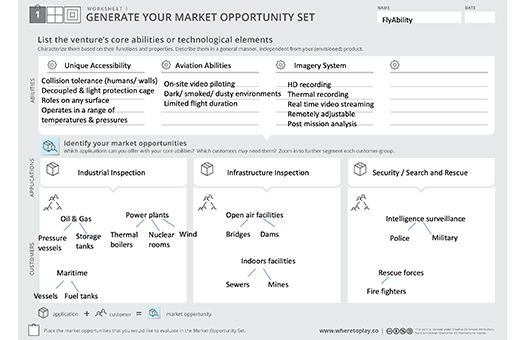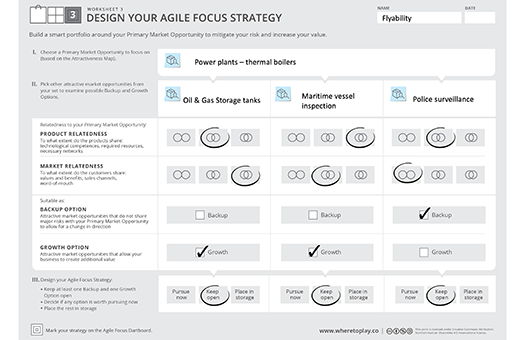Drive Profit and Innovation with "Where to Play"
March 19, 2022 Author: Ann Ralston

How do I decide which new business idea to pursue next?
Maybe you're an entrepreneur, seeing opportunity and possibility everywhere you look, wanting to start something significant.
Or maybe, your job in your existing organization is to manage and prioritize a pipeline or portfolio of money-making ideas for new products, services and business models.
But which of these many ideas will provide the most significant value, create the most substantial impact and have the highest likelihood of becoming a successful venture? Which are you best-positioned to execute? Most important, which should you pursue, next?
Where to Play by Sharon Tal and Marc Gruber (book) and the Market Opportunity Navigator (tools) help you determine where to invest your time and money for the best return on your new offering pipeline. The methodology has been successfully used in startups, university transfer offices, and existing organizations to find new opportunities, business, and revenue models.
- It is a framework for thinking through:
- Your product and market opportunities,
- If the opportunity is big enough, to be worth the trouble of pursuing it and,
- Where to focus on the best opportunities WHILE staying flexible and ready to change direction when needed.
- The creators share the methodology and tools (with web app), at no charge under a generous creative commons license!

Tal and Gruber designed these tools to help entrepreneurs and intrapreneurs think more flexibly about the markets where their product/service would be most successful.
According to the godfather of Agile Startup, Steve Blank, "It [the Where to Play Tools] can provide a big-picture perspective to find different potential markets for your company's competencies/abilities. This is the first step before you zoom in and design the business model, engage in focused customer development or test your minimal viable products." [read full article, here]
What if Uber used the Market Opportunity Navigator?
We are experiencing the convergence of disruptive technologies driven by the exponential drop in price/performance of compute power (Moore's Law) and a host of complementary technologies. Today's smart companies are combining the technologies to create valuable and fast-growing new products, services, platforms and ecosystems.
Uber, for example, leveraged under-used assets - most cars sit idle 90% of the time. When smartphones with GPS technology exploded onto the scene, Uber's apps and algorithms could locate and match up drivers and riders, taking a cut through their convenient payment process. The driver/rider rating system serves as a quality assurance mechanism. Seemingly overnight, Uber disrupted the taxi industry.
What if Uber wanted to expand those services into other markets? (Work with me for the sake of this example and imagine it's not yet happened.)
The Market Opportunity Navigator is a sequence of THREE worksheets (or web app) that help you make better decisions about Where to Play.
- The Market Opportunity Set pairs one or more assets/competencies with different applications.
- The Attractiveness Map assesses how attractive each market opportunity is.
- The Agile Focus Strategy helps design your business model to address an attractive market opportunity AND remain flexible.
The Market Opportunity Set

The Market Opportunity Set helps you identify your core competencies/abilities and play with how you can use them in other applications across customers, industries, geographies, etc.
Abilities:
- Identify your unique abilities, delinking them from the product. UBER has a matchmaking and payment system, an engineering team, software development, geolocation, proprietary algorithms, lobbying capability, etc.
Applications:
- Explore the ability or a combination of the abilities, including others you may consider adding for specific applications. Uber moves things from point A to point B.
- UBER leveraged its capability and expanded into multiple markets. Today they move people (UBER RIDE), food (UBER EATS). They are moving into the beverage space through their purchase of Drizly (2021), and grocery delivery in Latin America. They also partner with healthcare (UBER Health) and match carriers to shippers (UBER Freight). Today, Uber has expanded well beyond the original offering, leveraging its competencies (e.g. in matchmaking and its distribution network) and applying this to multiple markets.
Now that you have generated exciting opportunities, how do you rate or choose between the options?
The Attractiveness Map

The Attractiveness Map, based on patterns of VC investment, answers two questions:
- Is there a big enough opportunity?
- How challenging is the product/service to deliver?
Potential:
- What is the compelling reason to buy? (use the actual words of the customer).
- What is the market volume? Do the rigor to understand the current size and trend of the market.
- Is it economically viable? Is there enough margin? What about customer stickiness?
Challenge:
- Implementation Obstacles - How hard is it to do?
- Time to Revenue - what's the development time, time to produce, and length of the sales cycle?
- External Risks - are there 3rd party dependencies or other competitive threats?
Weigh and summarize your answers on the Attractiveness Map in one of 4 categories: A gold mine, moonshot, quick win, or questionable (not such a great idea). Tal & Gruber include a more rigorous list of questions in Where to Play that makes you think much more deeply about the relative attractiveness of your ideas.
After your first pass through this worksheet, VALIDATE your assertions/assumptions. Talk to the customers (again). Dig into the market research. Understand the sales cycle and get real on the implementation obstacles. THEN, update your worksheet. Rethink it. What would have to be true to increase the overall potential and decrease the challenges?
Move your top choices forward to worksheet 3.
The Agile Focus Strategy

The Agile Focus Strategy helps you BOTH focus AND be flexible - focus on the MOST attractive market opportunities and stay flexible enough to leverage other options that could create additional value.
The worksheet helps you explore how your various market opportunities are related by product and by market. For example, do two options share the same channels? Customers? Are the required technical competencies similar?
Can you see where they reinforce one another, allowing you to create additional value over time - a growth option? Will one option be a great backup option to use when you need to change direction? And most critically, what do choose to delay or dump?
With these clear choices, you can focus the development of your tech and patents, recruit employees, choose/design a culture, brand name, and even marketing materials AND still allow you to pivot and maintain a continuity of identity while making the most of the resources. You demonstrate to potential investors that you know the risks and have a backup plan if the original offering doesn't pan out as expected. Smart money follows good management.
Now, step back from the three worksheets. You have a high-level view of the potential company, with offering options. You've thought through the desirability, feasibility, and viability of each market/opportunity set and the risks and relationships between the offerings.
Additionally and most importantly, you have exercised the mindset and supporting tools to dig back into these or other offerings in the future.
Lessons Learned:
- Market Opportunity Navigator is both a set of tools AND a mindset - a new way to think about products and services.
- It is a valuable tool for both startups and existing companies.
- The worksheets work best with a team of people with diverse experience, expertise, and background.
- The first pass through the worksheets identifies assumptions that you then MUST validate.
- Where to Play gives you a way to focus on one offering AND the flexibility to pivot to other possibilities quickly.
About the Author
At Ralston Consulting Inc., both Ann and Gary Ralston are expert in coaching individuals and organizations successfully through their Where to Play journey. Book a free conversation to find out more and how we can help you.
Resources:
- Book: Where to Play: 3 Steps for discovering your most valuable market
- Market Opportunity Navigator Worksheets
- Market Opportunity Navigator App
- YouTube: Introduction to the Market Opportunity Navigator | Where to Play with Sharon Tal and Marc Gruber
Videos:
Intro to Market Opportunity Navigator - 2 min 10 sec
In-depth Interview with Where to Play co-author Sharon Tal 2022-04-04 - 28 min 57 sec
FAQ:
Q: How can the concepts of the Market Opportunity Navigator be practically applied in different industries or business settings?
A: The Market Opportunity Navigator helps companies identify, evaluate, and prioritize market opportunities. By utilizing the Market Opportunity Navigator's three steps, companies can make informed decisions about where to play by understanding their unique abilities, exploring different applications for those abilities, assessing the attractiveness of each opportunity, and designing a business model to address the chosen market opportunity while remaining flexible.
Q: Are there any case studies or real-life examples provided in the book "Where to Play: 3 Steps for discovering your most valuable market" to illustrate its effectiveness?
A: Flyability.com, a maker of inspection drones for confined spaces, is showcased in the short video, above. Freeze-frame the Market Opportunity Navigator template samples to review answers for Flyability, then visit their website to see what they're up to, now.
Q: What specific strategies or methodologies does Ralston Consulting Inc. recommend for identifying and capitalizing on market opportunities beyond the general steps mentioned in the article?
A: Several mental disciplines are required to leverage the Market Opportunity Navigator. The most powerful is "Un-Linking", in which you must shift your point of view to abstract the attributes of your product for your current market in its current use case. For instance, one might identify a Snickers® bar as satiating hunger pangs without overly spiking blood sugar.
This is followed closely by "Up-Framing", asking: "What is this an example of?" Asking this question, one might discover, for instance, that a Snickers® bar competes less in the class: 'Candy Bar' than in the class: 'On-theGo Meal Replacements'. See this TrendHunter article on a new, Low-Glycemic Index Snickers bar launched in China.
A third mental discipline is NOT falling in love with your solution. Many innovators/start-ups are convinced that their present solution is “THE” game changer. When you are SURE you know what you know, you stop looking for other options. Both curiosity and opportunity die.
